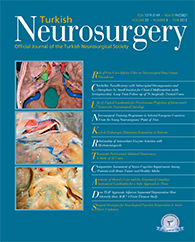2Gazi University, Faculty of Medicine, Department of Neurosurgery , Ankara, Turkey
3Gazi University, Faculty of Medicine, Department of Radiology, Ankara, Turkey DOI : 10.5137/1019-5149.JTN.5521-11.0 AIM: The patients who undergo neurosurgical procedures are at high risk for perioperative deep vein thrombosis and pulmonary embolism. Pharmacological prophylaxis with mechanic prophylaxis is a safe and effective way of preventing deep vein thrombosis and pulmonary thromboembolism in neurosurgery. However, pharmacological prophylaxis may increase the risk of hemorrhage after cranial or spinal operations.
MATERIAL and METHODS: Patients with vena cava inferior filter were retrospectively examined between 2003 and 2010.
RESULTS: Approximately 1600 patients per year are operated in our clinic. Deep vein thrombosis incidence is % 1.2 – 2.3 in our department. Vena cava inferior filter is used on 13 patients who operated for various diagnoses, during the 2003 – 2010 period. None of these patients had new pulmonary thromboembolism after inserting vena cava inferior filter but two of them died cause of initial respiratory distress.
CONCLUSION: We think that vena cava inferior filter in is safe and effective method for pulmonary thromboembolism prophylaxis, especially for patients with high bleeding risk and who cannot be anticoagulated. Further prospective studies with larger series are needed for evaluating long term complications and benefits.
Keywords : Vena cava inferior filter, Pulmoner thromboembolism, Deep venous thrombosis, Anticoagulation, Prophylaxis




